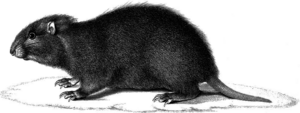Hispaniolan hutia facts for kids
Quick facts for kids Hispaniolan hutia |
|
|---|---|
 |
|
| Conservation status | |
| Scientific classification | |
| Genus: |
Plagiodontia
|
| Species: |
aedium
|
| Subspecies | |
|
|
The Hispaniolan hutia (Plagiodontia aedium) is a small mammal that looks a bit like a large rat. It lives only in the forests of Hispaniola, a Caribbean island shared by Haiti and the Dominican Republic. This animal is active at night, hiding during the day in burrows or trees. It mostly eats roots and fruits.
The Hispaniolan hutia is part of the hutia family. Sadly, it is an endangered animal. This means its numbers are very low. It is mainly threatened by forests being cut down and by new animals brought to the island, like rats or mongooses. It is the only living species in its group, Plagiodontia. Two other species from this group, which also lived on Hispaniola, are now extinct. Today, only the Hispaniolan hutia and the shrew-like Hispaniolan solenodon are the native mammals still found on the island.
Contents
What's in a Name?
The name Plagiodontia comes from Greek words meaning "oblique tooth." This name describes the special way its teeth are shaped. The common name "hutia" comes from the Taíno language, which was spoken by the native people of the Caribbean. They called this animal jutía.
How to Spot a Hispaniolan Hutia
Hispaniolan hutias have a body and head length of about 312 millimetres (12.3 in) (about 12 inches). Their tail is shorter, around 153 millimetres (6.0 in) (about 6 inches) long. An adult hutia usually weighs about 1.267 kilograms (2.79 lb) (around 2.8 pounds).
Their fur is short and thick, usually brownish or grayish on their backs and buffy (a pale yellowish-brown) on their bellies. Their tail looks scaly and has very little fur. Both their front and back feet have five toes. All toes have claws, except for their thumb, which has a short, flat nail. Female hutias have three pairs of nipples on their sides, near their chest.
What Do Hutias Do?
Hispaniolan hutias are mostly active at night. They are also known to live in trees. In places where they are kept and studied, they like to use special nest boxes placed high up. In the wild, they hide during the day and come out at night to find food. They mostly eat roots and fruits.
These hutias often live in pairs (a male and a female). Sometimes, three or four hutias might share the same burrow system. They communicate with each other using soft, quiet chirps that sound a bit like birds.
Hutia Reproduction and Life Cycle
Scientists have observed that female hutias can have a baby after about 119 to 150 days of pregnancy. They usually have only one or two babies at a time. Unlike many other rodents, baby hutias are born quite developed and can move around well soon after birth. This is called being "precocial." One hutia in captivity lived for almost 10 years!
Where Do Hutias Live?
Hispaniolan hutias can be found in both dry and moist forests on Hispaniola. They live on rough hillsides and in deep valleys, from sea level all the way up to 2,000 meters (about 6,500 feet) high. Some groups of hutias live in burrows in the ground and find their food nearby. Other groups might live in holes in trees and move through the branches instead of coming down to the ground.
Protecting the Hispaniolan Hutia
Two other types of hutias that used to live on Hispaniola are now extinct. Their bones are often found near old human settlements, suggesting they might have disappeared because people hunted them too much or because of rats brought by humans.
Today, the Hispaniolan hutia is still in danger. Its numbers and the areas where it lives have shrunk a lot. The main threats are:
- Deforestation: Forests are being cut down for farming as more people live on the island.
- Hunting: Hutias are often killed when people find them.
- Competition: Introduced rodents like rats and mice compete with hutias for food.
- Predators: Animals brought to the island, like the small Indian mongoose, as well as wild dogs and cats, hunt hutias.
The IUCN lists the Hispaniolan hutia as "vulnerable." This means it is at high risk of becoming endangered. Recent studies have shown that there are three different groups of Hispaniolan hutias.
Good news! Hutias have been found in several protected areas in the Dominican Republic. These include Jaragua, Del Este, Los Haitises, and Sierra de Bahoruco National Parks. They have also been seen in private protected areas like the Punta Cana Ecological Reserve. In 2005, photos confirmed their presence in the Bahoruco region, suggesting there might be a good number of hutias living there.
See also
 In Spanish: Jutía de La Española para niños
In Spanish: Jutía de La Española para niños
- Hutia
- Hispaniolan solenodon


